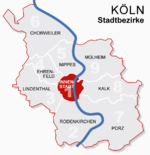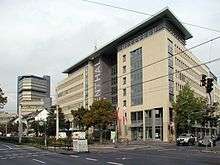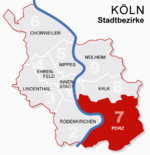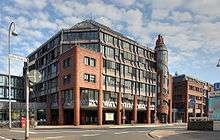Districts of Cologne
| This article is part of a series on the |
| City of Cologne |
|---|
Since the last administrative reform in 1975, the City of Cologne is made up of nine Stadtbezirke and 86 Stadtteile. Stadtbezirk literally translates as city district, which are further subdivided into Stadtteile (city parts). The Stadtteile of Cologne's old and new town (Alt- and Neustadt) further consist of quarters, known as "Veedel" in both Kölsch and most often, the Rhinelandic regiolect, as well.
City districts are differentiated of being links- or rechtsrheinisch – left or right of the Rhine, with the old town being left of the Rhine, as are 230,25 km² (56.8 percent of 405,14 km² within city limits), while 174,87 km² (43.2 percent) lie right of the Rhine. In regard to population, Cologne is the largest city in the state of North Rhine-Westphalia and the fourth largest city in Germany.
Districts
| Map | Coat | City district | City parts | Area | Population1 | Pop. density | District Councils | Town Hall |
|---|---|---|---|---|---|---|---|---|
 |
|
District 1 Köln-Innenstadt | Altstadt-Nord, Altstadt-Süd, Deutz, Neustadt-Nord, Neustadt-Süd | 16.4 km² | 127.033 | 7.746/km² | Bezirksksamt Innenstadt Brückenstraße 19, D-50667 Köln |
 |
 |
 |
District 2 Köln-Rodenkirchen | Bayenthal, Godorf, Hahnwald, Immendorf, Marienburg, Meschenich, Raderberg, Raderthal, Rodenkirchen, Rondorf, Sürth, Weiß, Zollstock | 54.6 km² | 100.936 | 1.850/km² | Bezirksamt Rodenkirchen Hauptstraße 85, D-50996 Köln |
 |
 |
District 3 Köln-Lindenthal | Braunsfeld, Junkersdorf, Klettenberg, Lindenthal, Lövenich, Müngersdorf, Sülz, Weiden, Widdersdorf | 41.6 km² | 137.552 | 3.308/km² | Bezirksamt Lindenthal Aachener Straße 220, 50931 Köln |
 | |
 |
 |
District 4 Köln-Ehrenfeld | Bickendorf, Bocklemünd/Mengenich, Ehrenfeld, Neuehrenfeld, Ossendorf, Vogelsang | 23.8 km² | 103.621 | 4.348/km² | Bezirksamt Ehrenfeld Venloer Straße 419 – 421, D-50825 Köln |
 |
 |
District 5 Köln-Nippes | Bilderstöckchen, Longerich, Mauenheim, Niehl, Nippes, Riehl, Weidenpesch | 31.8 km² | 110.092 | 3.462/km² | Bezirksamt Nippes Neusser Straße 450, D-50733 Köln |
 | |
 |
District 6 Köln-Chorweiler | Blumenberg, Chorweiler, Esch/Auweiler, Fühlingen, Heimersdorf, Lindweiler, Merkenich, Pesch, Roggendorf/Thenhoven, Seeberg, Volkhoven/Weiler, Worringen | 67.2 km² | 80.870 | 1.204/km² | Bezirksamt Chorweiler Pariser Platz 1, D-50765 Köln |
 | |
 |
 |
District 7 Köln-Porz | Eil, Elsdorf, Ensen, Finkenberg, Gremberghoven, Grengel, Langel, Libur, Lind, Poll, Porz, Urbach, Wahn, Wahnheide, Westhoven, Zündorf | 78.8 km² | 106.520 | 1.352/km² | Bezirksamt Porz Friedrich-Ebert-Ufer 64–70, D-51143 Köln |
 |
 |
 |
District 8 Köln-Kalk | Brück, Höhenberg, Humboldt/Gremberg, Kalk, Merheim, Neubrück, Ostheim, Rath/Heumar, Vingst | 38.2 km² | 108.330 | 2.841/km² | Bezirksamt Kalk Kalker Hauptstraße 247–273, D-51103 Köln |
 |
 |
 |
District 9 Köln-Mülheim | Buchforst, Buchheim, Dellbrück, Dünnwald, Flittard, Höhenhaus, Holweide, Mülheim, Stammheim | 52.2 km² | 144.374 | 2.764/km² | Bezirksamt Mülheim Wiener Platz 2a, D-51065 Köln |
 |
| Cologne | 405.15 km² | 1.019.3282 | 2.516/km² | |||||
| Notes: 1: population as of 31. December 2008 2: Statistical records of the City of Cologne include "second home residents", which state records exclude. Cologne's population as by statistical records of the State of North Rhine-Westphalia was 1,000,298 on 31. May 2009[1] | ||||||||
Growth of urban area

.jpg)
Since the city's foundation in 38 BC, Cologne grew through numerous extensions and incorporation of surrounding municipalities. Since the construction of the Medieval wall in 1180, the area of the old imperial city of Cologne has not changed for more than 600 years and was only extended over the old city walls in 1794, just short before the arrival of French troops and Cologne's incorporation into the First French Empire.
After 1815, the Kingdom of Prussia enforced the construction of fortifications which again hindered any growth for the city. Only with the acquisition of these fortifications in 1881, the city of Cologne had the possibility of a gradual territorial expansion. On 12. November 1883 a strip of territory from parts of the municipalities of Ehrenfeld, Kriel, Longerich, Müngersdorf and Rondorf was added to the city. At the time of the industrial revolution, industrial enterprises already avoided the densely populated areas inside of the city limits and settled in the small towns outside the fortified area, while maintaining close economic links to the city of Cologne. More than half of the estates here were in the hands of citizens of Cologne or the same becoming residents in these areas.
Since 1886, the Cologne City Council intensified negotiations with the surrounding communities, and on 1 April 1888 ended in a first major incorporation. Since then the city has expanded with major reorganizations in 1910, 1914, 1922 and 1975.
| Date | Incorporated localities |
|---|---|
| 1 April 1888 | town of Deutz; town of Ehrenfeld and present day Neu-Ehrenfeld; part of the town of Kalk; parts of the town of Mülheim (Mülheimer Hafen); parts of the muni. of Efferen (present day Klettenberg); muni. of Kriel (Braunsfeld, Kriel, Lind, Lindenthal, Sülz); muni. of Longerich (Butzweiler, Heimersdorf, Lindweiler, Longerich, Niehl, Stallagsberg, Volkhoven, Weidenpesch; muni. of Müngersdorf (Bickendorf, Bocklemünd, Melaten, Mengenich, Müngersdorf, Ossendorf, Vogelsang); muni. of Nippes (Mauenheim, Nippes, Riehl); muni. of Poll (Humboldt-Gremberg, Poll); parts of muni. of Rondorf (Arnoldshöhe, Bayenthal, Klettenberg, Mansfeld, Marienburg, Raderberg, Raderthal, Weißhaus, Zollstock) |
| 1 April 1910 | Höhenberg; Humboldt-Gremberg; town of Kalk; Ostheim; muni. of Vingst |
| 1 April 1914 | town of Mülheim (incl. Buchforst, Buchheim, Kleinbert); from Landkreis Mülheim: Bürgermeisterei Merheim (Brück, Dellbrück, Dünnwald, Flittard, Hardt, Höhenberg, Höhenhaus, Holweide, Kunstfeld, Merheim, Ostheim, Rath, Rodderhof, Scheuerhof, Schlagbaum, Stammheim) |
| 1 April 1922 | parts of Landgemeinde Worringen: Fühlingen (incl. Feldkassel, Kasselberg, Langel, Rheinkassel), Merkenich, Roggendorf, Thenhoven, Weiler, Worringen; parts of the muni. of Longerich |
| 1 January 1975 | town of Porz (Eil, Elsdorf, Ensen, Flughafen, Gremberghoven, Grengel, Heumar, Langel, Libur, Lind, Porz, Urbach, Wahn, Wahn-Heide, Westhoven, Zündorf); parts of the muni. of Brauweiler (Rath, Gut Vogelsang, Widdersdorf); parts of the town of Frechen (Horbell, Marsdorf); parts of the muni. of Lövenich; muni. of Rodenkirchen (Giesdorf, Godorf, Hahnwald, Hochkirchen, Höningen, Immendorf, Konraderhöhe, Meschenich, Rodenkirchen, Rondorf, Sürth, Weiß); parts of muni. of Sinnersdorf (Auweiler, Esch, Pesch, Gut Stöckheim); parts of the town of Brühl; parts of the munis. of Bornheim, Hürth, Pulheim and Rösrath. |
Source: Historical Archive of the City of Cologne[2]
References
- ↑ http://www.it.nrw.de/statistik/a/daten/amtlichebevoelkerungszahlen/rp3_juni09.html IT NRW (in German)
- ↑ Allgemeine Informationen zur Kölner Stadtgeschichte, Teil 4 (Vororte) Archived 24 May 2009 at the Wayback Machine. (in German)
External links
- Official site of the Stadtbezirke (in German)